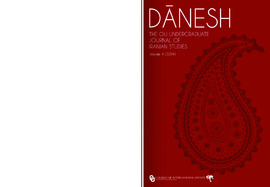| dc.contributor.editor | Kuyon, Kayleigh | |
| dc.contributor.editor | Standley, Corey | |
| dc.contributor.editor | Oberlitner, Adam | |
| dc.contributor.editor | Nazar, Jessamine | |
| dc.contributor.editor | Progler, Chris | |
| dc.contributor.editor | Albrecht, Emma | |
| dc.contributor.editor | Kayali, Sarah | |
| dc.contributor.editor | Ashbaker, Bailey | |
| dc.contributor.editor | Keaton, Joni | |
| dc.creator | Viviani, Jocelyn | |
| dc.date.accessioned | 2019-03-08T22:42:00Z | |
| dc.date.accessioned | 2021-04-14T15:38:40Z | |
| dc.date.available | 2019-03-08T22:42:00Z | |
| dc.date.available | 2021-04-14T15:38:40Z | |
| dc.date.issued | 2019-02 | |
| dc.identifier.uri | https://hdl.handle.net/11244.46/1526 | |
| dc.description.abstract | In post-revolutionary Iran, cinema became a medium for social critique of the prevailing issues in modern Iranian society. The problems of women under the Islamic Republic became a major focal point in these post-revolutionary Iranian films. After the revolution of 1979, Shi’a Islam reshaped the political and social landscape of Iran. At this critical juncture, the Islamic Republic under the religious authority and guidance of Ayatollah Khomeini was able to consolidate its power through the concept of velayat-e faqih, meaning the “the guardianship of the jurist.” By implementing the concept of velayat-e faqih in its system of government, the regime was able to enforce a political ideology based on its interpretation of Shi’a Islam. As a consequence, the regime’s ideology reshaped the fabric of Iranian society, particularly when it came to the position of women. This political ideology subjected women to the traditional roles of wives and mothers, and further Islamized the image of women through enforced veiling and cultural norms. As the Republic’s ideology began to shape every aspect of Iranian society, the problems of women became more apparent. The topic of women’s issues is significant in that women play an integral role in the social and political trajectory of Iran under the Islamic Republic. Without discussing and contesting the issues of women, political and social change for women in Iran becomes harder to obtain. | |
| dc.format.extent | 17 pages | |
| dc.format.extent | 898,098 bytes | |
| dc.format.medium | application.pdf | |
| dc.language | en | |
| dc.relation.ispartofseries | Danesh ; 4 (2019) | |
| dc.relation.requires | Adobe Acrobat Reader | |
| dc.rights | © 2019, University of Oklahoma. | |
| dc.subject.lcsh | Iran -- Civilization -- Periodicals | |
| dc.subject.lcsh | Iran -- History -- Periodicals | |
| dc.title | Post-Revolutionary Iranian Cinema: Unveiling the Reality of Iranian Women under the Islamic Republic | |
| dc.type | Document | |
| dc.type | text | |
| dc.contributor.sponsor | Farzaneh Center for Iranian and Persian Gulf Studies | |
| dc.description.undergraduate | undergraduate | |
